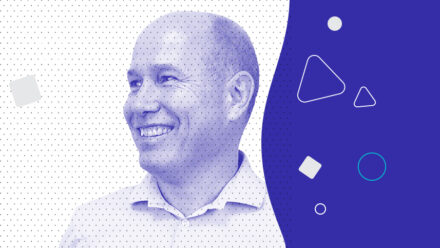Science in communications
By Duncan Smith

Here comes the science bit: 7 secret ingredients in the best communications
“Creativity is obviously at the heart of every truly great piece of marketing and that will always will be the case,” states Richard Chataway, one of the UK’s most experienced practitioners in applied behavioural science. “But we are at a tipping point,” he adds, “A great idea is now only one element of a successful campaign.”
“Today, we have an abundance of customer data and digital tools that open up a whole world of possibilities for marketers. Campaigns can be tested, adapted and improved over time. They don’t need to rely on outdated assumptions and personas, instead harnessing the power of personalised and personality marketing. And the very best marketing, triggers action using scientific insights into human behaviour.”
If anyone knows how to create a successful call to action using science, it is Richard. He has led communications strategy for the UK and Australian governments, was the Head of Ogilvy Change and has advised companies from IKEA to ITV, ING, Unilever, Sainsbury’s and Starbucks.
Richard believes that the more scientific the approach you take to marketing, the more likely you are to achieve success because often what you need to know is counterintuitive.
In this article, Richard outlines seven tips for marketers on how to ensure they are finding scientific insights and making the most of digital and AI developments.
Tip 1. Stand on the shoulders of giants
“There is an assumption in communications and marketing that research for every campaign should reinvent the wheel but that’s not necessary and not actually possible. There’s a famous quote from Isaac Newton which goes, ‘If I have seen further, it is by standing on the shoulders of giants,’ and this is true of marketing. There have been decades, centuries even, of scientific research into human behaviour. Marketers can take that existing knowledge and research and start applying those to their work.”
Tip 2. Experiment
“Marketing today is less about having one big idea and putting all your eggs in one basket, crossing your fingers and hoping for the best. It’s about recognising that actually there are a number of routes that might work and the only way to know is through testing, iterating and refining over time.
“That’s not how most marketing and communications works quite yet because in business, we don’t want to admit that we don’t categorically know. There’s a great book by the Freakonomics team called Think Like a Freak. One of its key arguments is that we should be comfortable saying ‘I don’t know’. That’s trained out of us throughout the education system, but it is the essence of a scientific approach.”
Tip 3. Think like a government
“Some of the more commercial organisations miss out on the rigor that governments insist on in their communications. Governments have to focus on changing behaviour rather than simply affecting attitudes or raising awareness, because otherwise it would be wasteful. When you need to recruit people to the armed forces or get people to respond to their tax returns, there are clear calls to action. You won’t get your project signed off if you aren’t clear on how you will trigger action or if you didn’t have the evidence to back it up. There is much more scrutiny and if you mess up, questions are asked in parliament. Nobody wants that!”
Tip 4. Test out the context
“People’s behaviour depends very much on the context. As an example, we developed scripts to be used by two businesses in their call centres to understand why people were cancelling subscriptions and try to retain their custom. One set of scripts was for a newspaper and the other was for a piece of IT software. We found they required a completely different approach to each other.
“With people calling up to cancel a newspaper subscription, we reflected social norms – ensuring that the customers knew that other people like them were subscribing and the benefits. This worked because a newspaper is about your worldview. It reflects your priorities in life. Not so for the software company because these were business customers and they are all seeking seeking competitive advantage – they want to be different to everyone else.”
Tip 5. Find your price point
“Before jumping into creative mode, spend time unpacking your thinking. Think about what assumptions you are making that you have no evidence for. What are you assuming about the way people are buying that product? How do people assess value?
“A good example of this is the principle of price anchoring. We all know, for instance, that people tend to buy the second cheapest wine on the menu. Rolls-Royce looked into this principle and found that their cars were seen as expensive at car shows, but not so if they exhibited at boat shows – where products can be worth half a million pounds. That’s an insight you only get by looking at subconscious influences of behaviour.
“Another example is that there is a bias to items to the left. So we recommended that a charity changed the order of suggested donations on its website from £5 £10 £50 to £50 £10 £5 and it generated an extra £850,000 in a year.”
Tip 6. Choose the right channel
“Most marketers will use the channel they think that their audience is most likely to be consuming. But actually this isn’t always what they are most influenced by.
“Look at advertising on the main TV channels, for example. TV still holds great influence as a channel because subconsciously people think that if a business can afford to advertise there then it is legitimate, and reputable.”
Tip 7. Move from personas to personality
“It is only relatively recently that we’ve been able to target people on an individual level and the technology in this area is developing quickly. Through the evolution of social media and big data, there are now sophisticated ways of assessing personality, beyond traditional techniques like Myers-Briggs.
“This is really powerful. Personality is a much better predictor of behaviour than demographics – we all know people in the same demographic as us who behave in a completely different way.

“How do you fuse this understanding of personality with marketing and the latest advances in machine learning and AI? And how do you do it ethically? This is the next frontier in behavioural science.”
Richard Chataway is the founder of Communication Science Group, which audits, optimises and scientifically evaluates communication to customers, clients and staff using behavioural and marketing science.




